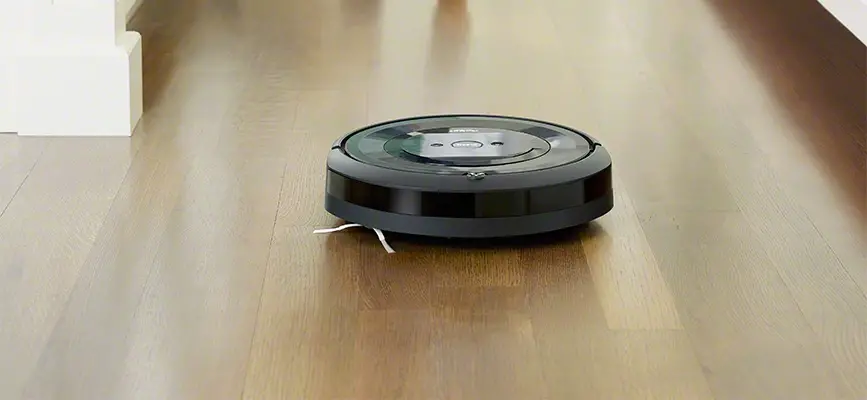Roomba was the first to introduce robot vacuums to the world and they are recognized as making some of the best models, so it seems almost blasphemous to ask, “is a Roomba worth it?” However, the truth is that some of their vacuums aren’t worth it.
Robot vacuums in general are definitely worth it. And if you’re looking to save money with an affordable Roomba, then you might find yourself with a loud, ineffective, poorly navigating vacuum that barely cleans your house. But, their premium models function as well as you’d imagine, making a world of difference between the two.
We’re going to take a look at affordable Roombas like the 600 series against premium models like the Roomba i7 to see the huge difference in their performance.
Navigation
If this is your first robot vacuum, then you might think that all robot vacuums have intelligent navigation and that they effortlessly glide around your home or apartment. The Roomba i7 is mostly like that. It uses odometry (or the number of wheel spins) along with an onboard camera to map your home and navigate around furniture, obstacles, and throughout every room with ease.
While it usually needs a few passes before it remembers each room, it will navigate through your home with ease once it understands the layout. It uses iAdapt 3.0 Navigation with Visual Localization as its navigating algorithm. One thing you should know is that Roomba always makes their navigation algorithms sound amazing. This means that the i7 will not only remember your layout, but it will change the map as needed for better navigation.
Over on the affordable side, the Roomba 675 uses iAdapt Responsive Navigation. Remember when I said their algorithms always sound great? This algorithm is supposed to take smart routes around your home and furniture. Unlike the Roomba i7 with its camera and odometry, the Roomba 600 series is closer to bump navigation.
This means it will keep going until it hits a wall or obstacle. It will then turn in a different direction and continue that way. While the Roomba 675 is better than some other bump robot vacuums, I can’t say that it’s smart. Also, it bumps so hard that it could leave scuffs.
It should go without saying that the premium Roomba is worth it while the affordable one doesn’t quite make the mark (though its bumping might leave a few marks).
Suction and Performance
Just like with navigation, many people think that a vacuum is a vacuum and there aren’t huge differences between them. So, is a Roomba worth it in this regard? Let’s take a look at Roomba i7 vs Roomba 675 to see if there’s a huge difference in suction and performance.
I would rank Roomba i7 as one of the better premium robot vacuums. It uses a Dirt Detect System that has its pros and cons. It keeps going over a spot until it can’t sense any dirt, but this also means that it needs more time to clean an area fully. Extra time aside, the i7 does a great job of cleaning both hard floors and carpets. It does a better job on carpets.
Overall, the Roomba i7 has the power you need to fully clean your home.
Inversely, the Roomba 600 series is one of the worst budget vacuums I’ve tested. I don’t mean just against the i7. I mean against other similarly priced robot vacuums like Eufy and Deebot. It seems to fail in every aspect. It only has one brush, lacks power, and the Dirt Detect System works against the weak battery and weak power. It will go over the same spot, again and again, ensuring that your home takes forever to clean.
I think it goes without saying that once again the premium Roomba wins this one. No one likes spending more money, but you also don’t want to spend money on an affordable vacuum that can’t clean your home.
Runtime
On paper, both of these Roombas have similar battery life. The Roomba 675 has a 60-minute battery life while the Roomba i7 offers 75 minutes. Don’t let that fool you. Even here, there’s a big difference between them.
Remember when we said that the Roomba i7 is better at navigating and mapping your home? That plays a crucial role here. It’s rare for the i7 to finish your home in one pass. It will likely need to recharge in the middle of its cleaning cycle. So, it returns to the charging base before the battery runs out. This ensures that it can clean your home without dying randomly in the middle of a room.
The Roomba 675 and other 600 series Roombas can find their charging base if they’re right next to it, but otherwise, they tend to struggle to recharge in the middle of their cycle. Don’t be surprised if you find the 600 series dead in some random location. You might even need to hunt for it if you have a big house.
Both of them can recharge during their cleaning cycle, but the 600 series struggles to find the charging base while the i7 does it with ease.
Software
The last area I’ll touch on is software. While there is a difference here, I will say that both affordable and premium Roombas have great software. iRobot outdoes the competition here by offering one of the best apps.
Connecting the Roomba i7 is a breeze and you can even connect it with Google Home or Alexa. Want to make your Roomba even more useful? Use a nifty IFTTT command. For example, you can make the Roomba pause whenever the phone rings. The scheduling option allows you to schedule times, days, and rooms to clean.
Speaking of adding to the i7, there is an optional Clean Base that collects dirt, debris, and pet hair. The base cleans the dust tray and holds up to 30 trays worth of debris. The Roomba i7+ automatically comes with this, or you can buy the Clean Base separately with the i7.
On the Roomba 675 side, it also uses the iRobot app and is compatible with Google Home and Alexa. You can make a schedule, and you can even see the battery life and overall robot health with the app. However, there is no IFTTT support and the initial connecting can be daunting.
Overall, both perform well with their software. The i7 is better and has more options, but the 675 covers all the major bases and is surprisingly robust considering its price.
Understanding the Technical Differences
Knowing the differences in the models is one thing, but understanding how these differences affect the performance of each Roomba is another. Let’s delve into the technology behind these models to give you a clearer idea of why the premium models outshine the more affordable ones.
The Roomba i7, for instance, uses a combination of two technologies: vSLAM (Visual Simultaneous Localization and Mapping) and iAdapt 3.0. Together, these two tech aspects allow the i7 to create a real-time map of your home, understand its positioning in it, and adapt its cleaning strategies. This means it’s capable of cleaning more complex layouts with multiple rooms, unlike the budget models which operate on a less intelligent iAdapt 1.0 system.
The cheaper models, such as the 675, use a simpler technology that involves making random turns whenever they hit an obstacle. Essentially, they clean by following an algorithm of randomness, which isn’t very efficient, and often leaves some spots untouched. It’s a bit like letting a toddler loose with a duster – he might do a decent job, but you wouldn’t really rely on him for thorough cleaning.
Considering the Role of Maintenance
Maintenance and ease of part replacement is another factor to consider when choosing a Roomba model. Over time, components like brushes, filters, and batteries will wear down and need to be replaced. The premium models like the i7 typically have more readily available replacement parts, making them more practical in the long run.
While it’s true that the 600 series also have replacement parts available, the frequency of replacement might be higher due to the machine’s more strenuous operation. Given the 675’s inferior suction and navigation, it’s likely to have a shorter lifespan for its components. Ultimately, this could lead to you spending more time and money on maintenance than you’d prefer.
Final Thoughts
So, is a Roomba worth it? In general, I would say yes, but only if you get the right one. The Roomba 675 is an affordable vacuum with a great price point, but it suffers from poor suction, bad navigation, and reduced overall functionality. It might work well for some people, but it’s honestly more of a toy than an appliance. Many other budget robot vacuums work better and are even priced better.
If you want to see what makes Roomba a great brand, then you need one of their premium models like the Roomba i7. This one has the power, navigation, smarts, and functions needed to clean your home with ease. I know no one likes spending more money, but this one is worth it.
FAQs
Does the Roomba i7 work well with pet hair?
Yes, the i7 is known for its excellent performance with pet hair, thanks to its superior suction power and dual multi-surface rubber brushes that effectively pick up hair without getting tangled.
How often do I need to replace parts on the Roomba i7 and 675?
It largely depends on usage, but generally, parts like the filter and brushes on the i7 should be replaced every 6-8 months, while the battery lasts for about 2 years. For the 675, due to its rougher handling, parts may need replacing more often, around every 3-5 months.
Do the Roomba i7 and 675 models need a Wi-Fi connection to work?
Both models can operate without Wi-Fi, but a connection is needed for the iRobot Home App, which lets you schedule cleanings, check cleaning history, and access other smart features.

